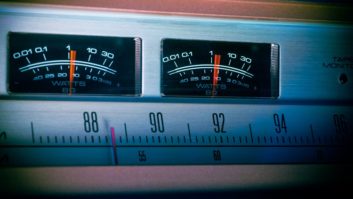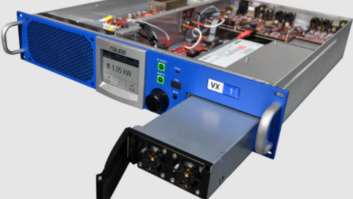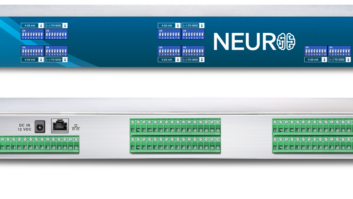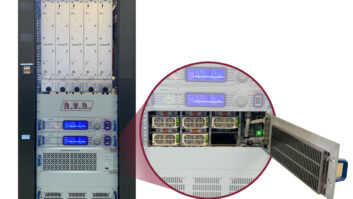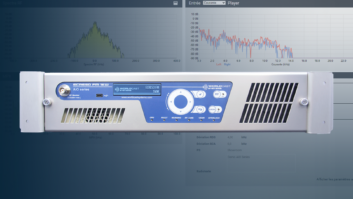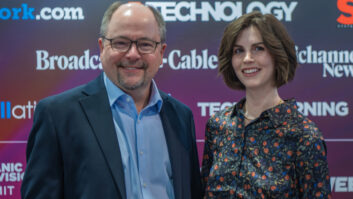The HDA600 stereo headphone amplifier from Audio Technologies Inc. is not your ordinary headphone amp.
This is a versatile product that can be at home in many audio applications, such as in the radio studio, recording studio and language lab. It can even be used as an intercom system.
Product CapsuleThumbs Up
Useful in many applications
Can be configured through internal jumpers
Cue insert capability in left, right or both channels
Thumbs Down
Unregulated power supply
Stereo direct inputs are unbalanced
Price: $599
For more information from Audio Technologies Inc. contact the company in Pennsylvania at (215) 443-0330 or (800) 959-0307 or visit www.atiguys.com.
The headphone-driving circuitry uses a combination of high-output voltage swing (16 V p-p) for high-impedance headphones and a protected high current capability (0.2 A) for low-impedance phones. The HDA600 will drive 32- to 600-ohm stereo headphones to near 120 dB SPL.
A word of warning – the high output of the HDA600 may be required for the aging rock-jock with marginal hearing, but those who still have pristine hearing should employ caution.
Distortion is published as less than 0.1 percent with response flat to +/-0.25 dB from 20 to 20 kHz.
Housed in a one-rack-unit enclosure, the HDA provides a stereo program input plus a mono cue input that drives six stereo headphone outputs. The HDA600 will bridge balanced and unbalanced program input lines with individual left and right XLR and 1/4-inch tip-ring-sleeve (TRS) input connectors.
The spare connector set may be used to loop through the input signal to additional HDAs. Inputs are electronically balanced but will operate properly when an unbalanced 1/4-inch plug is inserted.
An internal input selector plug optimizes the input stage gain for either -10 or +4 dBu nominal inputs and the program input clip indicator shows input overdrive. A master level control and mono/stereo switch adjust the program signal fed to the output channels via an internal stereo distribution bus.
The mono/stereo switch allows a quick check of the mono compatibility of the stereo mix; two separate mono signals, applied to the stereo inputs, can be summed easily for monitoring. Each of the six headphone output channels has a level control.
A balanced cue input at microphone or line level is brought into the unit through paralleled XLR and TRS connectors. Microphone or line level for this input is selected with the rear-panel mic/line switch.
Line level for stereo inputs is selected at -10 or +4 dBu with an internal jumper plug. Phantom power suitable for most electret-type microphones (+12 VDC) can be selected with an internal jumper plug and is switched on only in the microphone mode with the mic/line switch. The cue signal may be selected into right, left or both distribution busses with front-panel pushbuttons.
A cue-level control and cue-clip overdrive indicator is included. The cue input could be used to add an IFB or mix-minus feed into the mix in an on-air application or a click track into one channel in a recording studio.
It would be nice to have another cue input so that separate audio could be sent to either left or right channels.
Six individual output channels bridge the internal stereo distribution bus and drive paralleled front- and rear-panel 1/4-inch TRS output jacks. The high-compliance output circuitry comfortably drives stereo headphones from 32 to 600 ohms.
Although the unit is designed to drive either front or rear outputs, two sets of headphones can be plugged into a single channel with reduced drive to each. The rear jacks also can feed remote headphone distribution boxes. This is a nice feature for those who like to rack-mount their equipment and hide the wiring. Individual output channels can be setup for mono headphones with a tip-sleeve plug.
Direct inputs into each output channel are available on the rear panel. A TRS plug wired as unbalanced stereo, inserted into a direct input, will interrupt the main mix and feed its own stereo signal through that channels amplifier and output jacks.
Individual direct inputs can be configured as balanced mono inputs by moving internal jumper plugs to the “Bal Mono” position. I would prefer that the direct inputs be bridging like the line inputs. A signal present indicator LED for each output channel glows at about 30 dB below nominal input levels.
The HDA600 will operate at 115 or 230 VAC depending on where the internal jumpers are set. I am not sure why the internal bipolar DC supply is not regulated; an unbalanced supply could cause distorted waveforms.
I tested the amp with a pair of Sony MDR-7506 headphones and was pleased with the sound. With the channel and master controls at full level, I could not hear any noise. The sound was clean and balanced. with no perceptible distortion at normal listening levels.
The 100 mW outputs of the HDA600 could drive a speaker for a paging or intercom system. Just add a push-to-talk switch and a microphone to the cue input and you are set.






